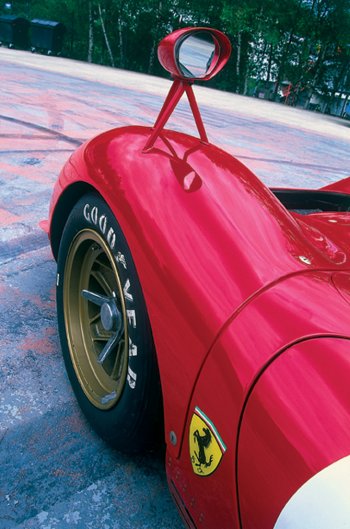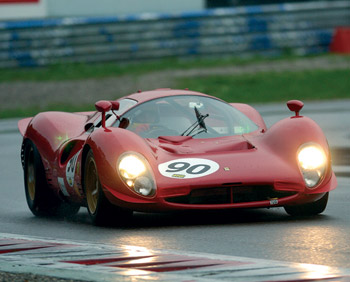|
This
feature appears in Auto Italia - Issue 118 |
|
|
Motoring writers are often
asked which is the best car they have driven. It is an
impossible question to answer unless you precisely define
the word ‘best’. Best car to spend a few hours in a traffic
jam? Best car to leave in the station car park? Best car for
a family holiday? Best car to run on a shoe-string? It is a
question I have always sidestepped, until today at the
Spa-Francorchamps circuit. Something is telling me that this
1966 Ferrari P3 takes the title. Officially a P3/412P and
sometimes a 330P3 or P3/4, in the interests of ink
conservation let’s call it a P3.
P3 chassis number
0844 was made in 1966 and is the first of only three. I was
looking forward to comparing the P3 with preceding endurance
Ferraris as well as those that followed: the 512S, 512M and
312P – all of which I have driven. In 1966, Ferrari was at
war with Ford. Following a failed takeover bid, Ford wanted
a showdown with Ferrari. The gunfight at the OK Corral was
being re-enacted at Le Mans. Ferrari first won Le Mans in
1949. Between 1960 and 1965 Ferrari totally dominated the
24-hour race. Ford had its revenge with wins in 1966/7/8/9
with the 7.0-litre GT40s. After doing battle with Ford,
Ferrari had waves of Porsche 917s coming at them. Although
Ferrari went on to have countless ‘normal’ race wins, the
red cars never won Le Mans again. One of this P3’s race wins
was right here at Spa-Francorchamps in the 1966 Spa 1000Km.
Our day at Spa is being run
by trackday supremos RMA. See RMA-limited.com to find out
about the King of Trackdays. The P3 is supplied by the
ever-impressive Tim Samways Sporting and Historic Car
Engineers (see www.timsamways.co.uk). This car came in from
the USA in, let’s say, ‘show condition’. Samways totally
rebuilt the P3 to race spec and it has since been campaigned
successfully in the Shell Historic Ferrari Challenge.
Strolling up to the P3 and
ignorant of its outstanding history I make notes. It is a
low car – well below waist height. I can feel its presence
and I don’t know why. The colour is that sort of bluey red.
Similar to Alfa red (a bit like Alfa 501 to paint-spotters).
Then there are the rivets to remind you that this is a
man-made aluminium car although the doors are in glassfibre.
Peer in and you spot the steel tube spaceframe chassis with
aluminium floor and inner panels. Tyres are Goodyear
Historics 600x15 at the front and 800x15 Blue Streak Sports
Car Specials at the rear on beautiful centre-lock
Campagnolos with triple-eared spinners. I continue my walk
around the car. Air enters the nose and radiator to escape
just ahead of windscreen. Nose fins provide a few kg of
front downforce. High front arches have a pair of mirrors on
tripods rising high so that from the driver’s seat the rear
view is over the rear deck. Two more mirrors are set close
to the driver: one on the screen pillar the other inside and
just off-centre. The rear panel is vented for cooling and
the subtle rear lip has a beneficial aerodynamic effect by
reducing lift as well as cutting off the air stream and
reducing drag. The windscreen, cockpit, roof, side glass and
rear screen form one beautiful teardrop shape; from days
when style mattered even on a race car. Under the rear deck,
its 4.0-litre V12 is fed by a stack of Webers, and scavenged
by those beautifully bunch-of-banana exhausts that helped
make the Ferrari F1 cars of the period look so good. Indeed,
many say that this P3 is the world’s best-looking racing
car.
Time to make notes from the
cockpit. Problem – the seat is one of those individually
created foam jobs: tailor-made for a specific driver and one
smaller than me (Peter Hardman). No problem as these types
of seats simply rest in the car and are held in place by the
strapped-in driver. With the seat removed and just a small
sheet of foam, my new sitting position is perfect. Room to
manoeuvre, plus headroom, gearlever room, steering wheel
room, pedal room.... all just so.
The solitary seat is
positioned almost in the centre of the car. Typically, the
P3 is right-hand drive since this is an advantage on
right-hand race circuits and most circuits are clockwise.
With such a low roof, the sitting position is reclined
giving a large surface area for support and negating the
need for padding. A Willans six-point harness clamps you to
the car. The tiny Racetech steering wheel removes for easy
entry as there is a right-hand gearlever to negotiate. The gearlever has sliding
fingers to prevent gate-jumping and a reverse lock-out.
First gear is on a dog-leg, left and back. Pedals are offset
to the left for wheel arch intrusion. There is also a dead
pedal for the left foot. Straight ahead, the tacho red-lines
at 7750rpm, flanked by just two smaller instruments for
water temp and oil pressure. Ignition and starter button are
on the right. On the centre console there are two further
instruments for oil temp and amps plus a big oil light and
an electric kill-switch.
The world's most beautiful racing car and
the world’s most beautiful race track await. Combining the
two borders on the surreal. Spa is a drivers’ circuit. What
makes it so is simple – trees and gradients. The only
exception to this rule is Monaco, and even then you do have
trees; it’s just that they’re tall, rectangular, made of
concrete and cost a lot of money.
|
 |
|
Strolling up to the P3 and
ignorant of its outstanding history I make notes. It is a
low car – well below waist height. I can feel its presence
and I don’t know why. The colour is that sort of bluey
red. |
|
 |
|
|
 |
|
Ferrari P3 chassis number 0844
was made in 1966 and is the first of only three. In
1966, Ferrari was at war with Ford. Following a
failed takeover bid, Ford wanted a showdown with
Ferrari. |
|
 |
|
The solitary seat is positioned almost in
the centre of the car. Typically, the P3 is
right-hand drive since this is an advantage on
right-hand race circuits and most circuits are
clockwise. With such a low roof, the sitting
position is reclined giving a large surface area for
support and negating the need for padding.
|
|
|
Gradients provide 3D visibility in corners such as Eau
Rouge, as well as the excitement of blind brows. Meanwhile
the passing trees give a sense of speed. The very nature of
a driver’s circuit is that space and run-off areas are often
at a premium, ie
mistakes are costly.
Turn the key, press the
button and 12 cylinders explode into action and bring the
car alive. Left and back on the lever for the long first
gear and slip the clutch until up to speed. It is easy to
get blasť in this job but driving out of the pits and onto
the Spa circuit reminds you otherwise. The non-synchro
gearbox operates like a switch. Whap, whap, whap through the
gears as clean as a whistle. That Ferrari was making cars
like this in 1966 at the same time as ponderous road cars,
shows just how far a racing car from any period is from a
road car. Down the long straight, the P3 screams to 7000rpm
in fifth by the halfway point. How fast should I go? Should
I ease off?
We must be travelling at a
hell of a speed but the car feels rock-solid. I wait until
the 200-metre board and brake for Les Combes. It becomes
obvious that the P3 will still slow down enough even if I
wait for the 100-metre board. A bit like waiting until you
see the spectators’ jaws drop before hitting the brake
pedal. Dive, squat and roll are minimal. The set-up is a
good compromise for varying conditions. Torque is immense
and at 5000rpm the P3 rockets away. With such acceleration
it could make a driver lazy. Point-and-squirt is not the way
to get round a track. You need to carry speed into corners.
The P3 does this with initial and very mild understeer, with
a dash of power oversteer on exit. This is no sideways rally
car but slip angles need to be there in measured amounts for
proper driving – something much harder to achieve with later
cars. Considering the ancient
rubber, grip is amazing, and a sure sign of a brilliant
chassis and well-designed suspension. Steering is
super-quick, response is instantaneous and direction change
immediate. Aiming the P3 between those high front wings, the
view ahead through that gorgeous windscreen is
awe-inspiring. Bringing the P3 back into
the pits is difficult. I want to stay out in it – a sure
sign of a great racing car. This P3 does feel more
old-fashioned than the later 512S, 512M and 312P but in no
way does it feel worse. It may be slower than later Ferraris
but the P3 is easier to drive.
Snags: just one. The view
through the interior mirrors is clouded by reflection
through that long sloping rear perspex screen. The front
wing mirrors should be convex as the distant flat glass
presents a microscopic field of vision. Surrounded by four
mirrors, rear vision is poor.
Finally: it was after
writing the track test that I acquainted myself with P3
0844’s noble history. Had I known whose bums had sat in this
P3 my words might have been blinkered as the period pilots
were my teenage heroes. I told you the car had presence.
Competition History of
Chassis Number 0844: 1966
April, Monza 1000Km, John Surtees/Mike Parkes: 1st, Pole Position,
Fastest Lap; 1966 May, Targa Florio, Nino Vaccarella/Lorenzo
Bandini: Did not finish; 1966 May Spa-Francorchamps 1000Km, Mike Parkes/Ludovico
Scarfiotti: 1st, Pole Position, Fastest Lap; 1966
June Le Mans 24 Hours, Lorenzo Bandini/Ludovico
Scarfiotti: Did not finish; 1967
Feb Daytona 24 Hours, Pedro Rodriguez/Jean Guichet: 3rd; 1967
April Monza 1000Km Pedro Rodriguez/Jean Guichet: Did not finish; 1967
June Le Mans 24 Hours, Pedro Rodriguez/
Giancarlo Baghetti: Did not finish; 2003 and Beyond: Driven by both Peter Hardman and Harry Leventis, the car’s
race history has continued,
including regular victories in the Ferrari Maserati
Challenge
TECHNICAL SPECIFICATIONS:
Engine: 3960cc V12 mid-longitudinal, 4 overhead cams, 2 valves per cyl; Bore x
stroke: 77mm x 71mm Ignition and
fuel: Twin-plug Marelli ignition with 6
twin-choke Weber 40DCN;
Power: 410bhp @ 8200rpm;
Transmission: Ferrari-type 603 transaxle,
non-synchro dog construction 5-speed manual plus reverse,
choice of transfer gear ratios to suit each circuit; Brakes: Girling
ventilated discs and alloy calipers;
Wheels: Centre-lock Campagnolo;
Tyres: Goodyear Historic 600x15
front; Blue Streak Sports Car Specials 800x15 rear; Kerb
weight: 700kg approx;
0-60mph: 3.5sec (est); Top
speed: 150-200mph depending on gearing; Current
value: £6m approx.
Test by Roberto Giordanelli / Photography by
Paul Jarmyn
|
|
This feature appears in Auto Italia, Issue 118. Highlights of
this month's issue of the world's leading Italian car magazine, which is now on sale, include Alfa 159, - the world's most beautiful
estate car? Lancia Delta Integrale Rally -
London to Brighton run; and Ferrari Dino -
Budget Ferrari.
Call +44 (0) 1858 438817 for back issues and subscriptions. |
|
|
website:
www.auto-italia.co.uk |
|
|
![]()
![]()